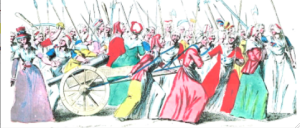One thing I’ve learned…
while researching this book in Paris, is there are enough individual sad stories about the French Revolution to fill an entire book. This really hit home when we visited the Picpus Cemetery in the 12th district.
Picpus is the only private cemetery left in the city of Paris. It is a cemetery born out of the Revolution. For background purposes, let me take you to 11 June 1794. France and Paris in particular are in the depths of the period called “The Terror.”
The Terror
The guillotine has been dismantled and moved to the “Square of the Overturned Throne.” This in now known as the place de la Nation (Métro: Nation). For the next 46 days, 1,306 people were executed here. Only on 27 July 1794 or 9 Thermidor was the blade of the guillotine silenced. Robespierre was arrested, attempted suicide, and held at various locations.


